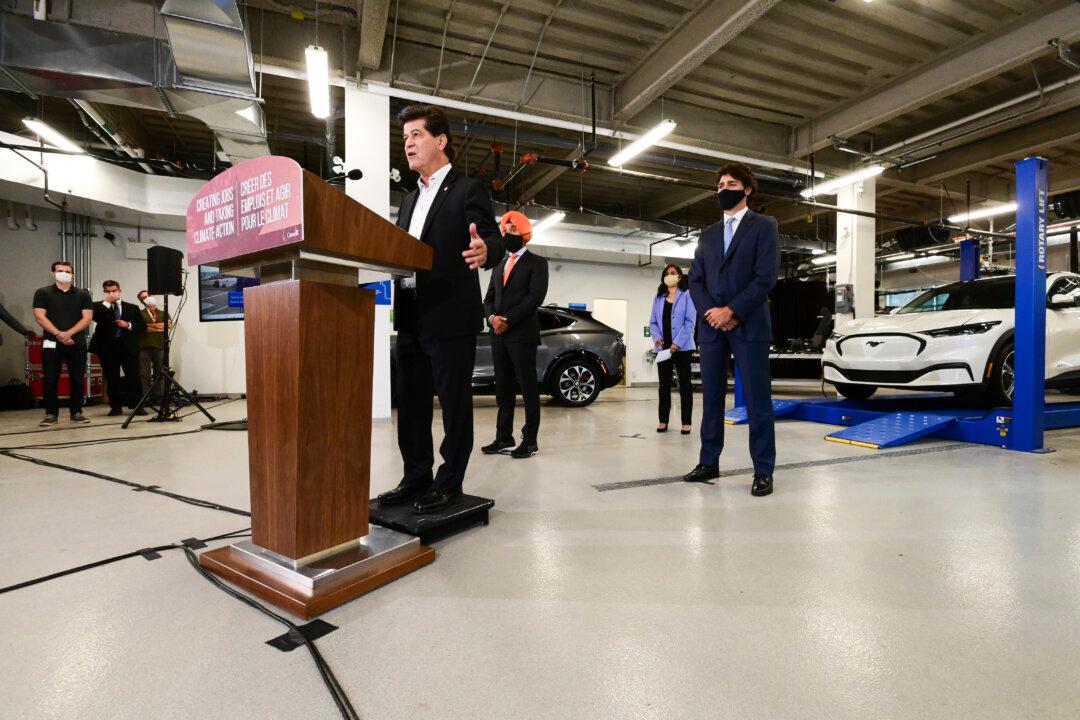It’s nothing new for the feds and Ontario to be pumping taxpayer dollars into the auto sector.
The latest example is the governments of Canada and Ontario, on Oct. 8, saying they’ll pay a total of $590 million to help Ford’s Oakville plant pivot to start producing battery electric vehicles (BEVs). This is part of a three-year agreement worth nearly $2 billion between Ford of Canada and Unifor, Canada’s auto workers union, signed in September.
The federal and Ontario governments want to transform Canada into a global leader to meet the projected boom in demand for BEVs and batteries.
Critics have raised concerns about the hundreds of millions of taxpayer dollars flowing to a company like Ford worth over US$30 billion. They wonder how long newly created jobs will remain in Canada, what the payoffs of the investments will be, and what other automakers will expect.
The governments are trying to force consumers to change their behaviour through subsidies and rebates rather than letting market forces do their work, says Germain Belzile, economics professor and senior fellow at the Montreal Economic Institute (MEI).
He describes that as a flawed effort.
Questions remain about how far a BEV can travel on a charge, functionality in brutal Canadian winters, and the lack of charging stations. The conditions for mass adoption aren’t present yet.
“You can’t think there’s going to be a spontaneous attraction to electric cars as long as they have these big disadvantages,” Belzile told The Epoch Times.
Canada has set a sales target to have all light-duty vehicles sold by 2040 be zero-emission vehicles (ZEVs), which include BEVs, plugin hybrid electrics, and hydrogen fuel cell cars. That would mean selling 14 million ZEVs in 2040, when by 2025, the government projects just 825,000 ZEVs to be sold.
The feds see plenty of additional benefits arising from the supply chain that will develop around BEV production. That includes demand for metals and minerals and capitalizing on the mining sector in the production of batteries.
The feds expect the provinces to put together rebate programs for buyers of BEVs and make infrastructure investments in things like charging stations, Navdeep Bains, Minister of Innovation, Science and Economic Development, told CTV.
Prime Minister Justin Trudeau called the announcement a “win-win” for Canada’s auto sector and the environment and said the deal will secure 5,400 well-paying middle-class jobs.
Governments have essentially mandated production of BEVs through various subsidy and rebate initiatives over the years and Belzile says it will be “doubly costly” if Canada is to have, by 2040, every light-duty vehicle sold being a ZEV.
“You lose tax revenue on gasoline. Governments will have to stop subsidizing at some point and also start taxing electric cars, maybe per kilometres driven,” Belzile said.
Recent evidence has shown that if Canadians are to buy ZEVs, they need generous rebates. Sales of ZEVs dropped sharply in Ontario in the first half of 2019 after the Doug Ford government canceled the rebate.
The Epoch Times contacted Transport Canada regarding the amount of rebates anticipated given the projections for ZEV purchases over the next 20 years.
The feds remain committed to their ZEVs targets of 10 percent of light-duty vehicles sales per year by 2025, 30 percent by 2030, and 100 percent by 2040.
“Any changes in funding for the program would be reviewed at the appropriate time and as needed,” said Livia Belcea, press secretary to the Minister of Transport, in an email.
Hidden Tax
Dealing with climate change is a high-ranking priority for Canadians, but 61 percent said they are unwilling to pay anything more in taxes to do so, according to an August Ipsos poll conducted on behalf of the MEI.
Belzile says the government knows this and will try to hide the way it taxes Canadians to meet environmental targets—using subsidies instead. It’s a matter of optics and politics.
“Subsidizing can only be popular with people who buy electric cars and it doesn’t elicit much of a negative response from people who don’t really see that if you subsidize something, you have to tax people for that,” he said.
Carleton University business professor Ian Lee previously recounted a similar story to The Epoch Times about Ontario’s highly flawed, generously subsidized push into green energy by guaranteeing above-market prices for a minimum of 20 years.
“It’s a subsidy program where you charge everybody else and then pay it to the people who are being paid to produce solar and wind because it wasn’t economic to produce,” he said.
But Unifor national president Jerry Dias says now is the time to make these investments or be left behind for the long term.
Unifor stated in the document outlining the deal with Ford that, “Canada has not seen one dime of the more than $300 billion in global investments announced for electric vehicle production.”
But even with the significant catching-up that Canada has to do, the governments’ aim is for Ontario to become a global hub for BEVs.
There is a fair distance to travel for that goal as the technology still needs to improve, said Belzile.
“Canada is a minnow in a very big pond in terms of this industry,” he said.
Unifor hopes the new agreement can start to change that and that similar deals with other automakers will follow.
“The pattern has been established with Ford. We’ll be dealing with Fiat Chrysler next,” Dias told BNN Bloomberg in a September interview.
“People don’t make major announcements in any country, unless governments are playing a role,” he added.
Bains confirmed that the feds intend to work with other automakers and evaluate their business plans.
General Motors Canada confirmed to The Epoch Times in an email that it is currently bargaining with Unifor.





